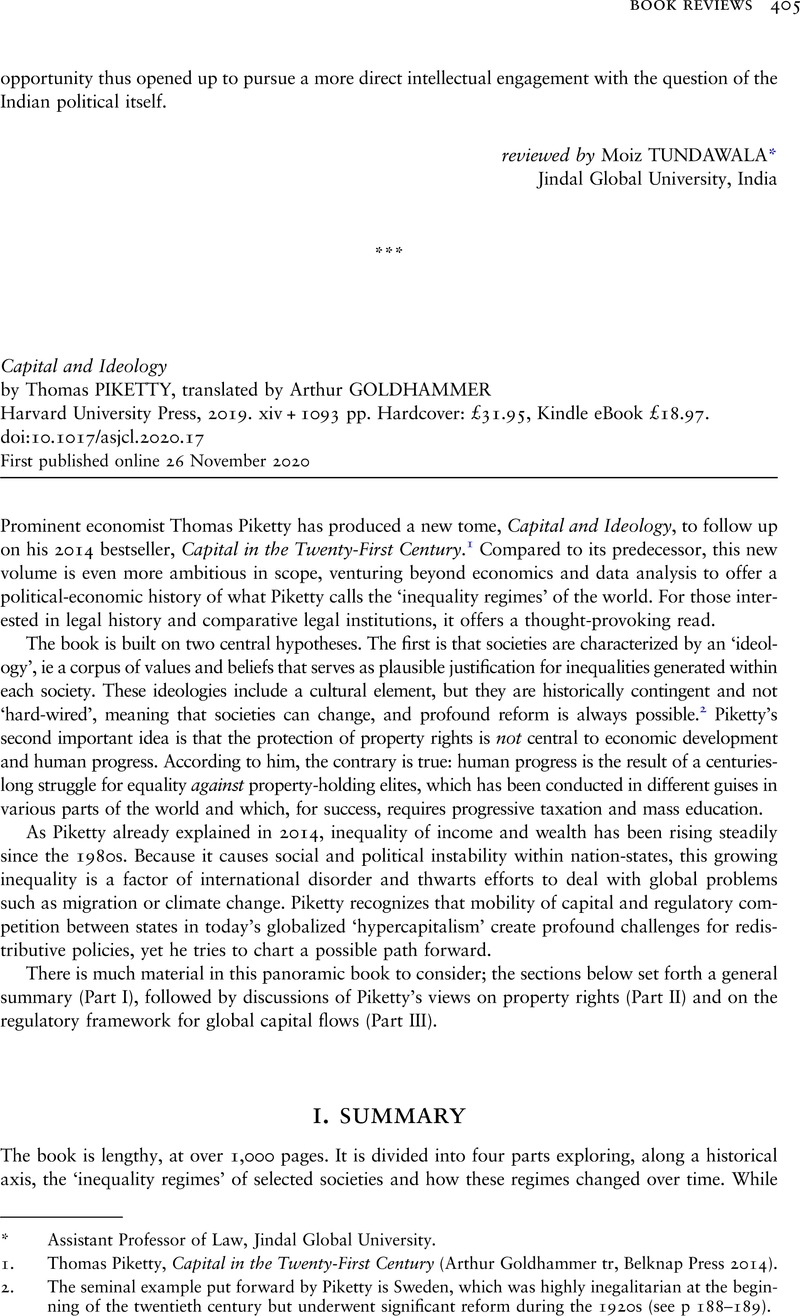No CrossRef data available.
Article contents
Capital and Ideology by Thomas PIKETTY, translated by Arthur GOLDHAMMER Harvard University Press, 2019. xiv + 1093 pp. Hardcover: £31.95, Kindle eBook £18.97.
Review products
Published online by Cambridge University Press: 26 November 2020
Abstract

- Type
- Book Review
- Information
- Copyright
- Copyright © National University of Singapore, 2020
Footnotes
Assistant Professor of Law, Jindal Global University.
References
1. Piketty, Thomas, Capital in the Twenty-First Century (Goldhammer, Arthur tr, Belknap Press 2014)CrossRefGoogle ScholarPubMed.
2. The seminal example put forward by Piketty is Sweden, which was highly inegalitarian at the beginning of the twentieth century but underwent significant reform during the 1920s (see p 188–189).
3. Figure 4.1, p 128, on ‘the failure of the French Revolution’.
4. According to Piketty, reforms in 1867 and 1884 increased male suffrage in the UK to 30% and then 60% (p 177). In France, universal male suffrage was established in 1871.
5. Annual financial extraction is estimated at 4–7% of national income during 1760–1790, and 5–8% during 1890–1914, ie after the abolition of slavery (p 280). The extent of post-independence extraction imposed by France upon Haiti is particularly egregious, both for the amounts involved and for the principle that financial compensation was deemed necessary for slave-owners rather than for the slaves themselves.
6. pp 323, 342.
7. Figure 9.2, p 366.
8. Table 17.1, p 982. Inheritance taxes are also proposed at progressive rates from 5% to 90%.
9. p 1002–1003.
10. p 990.
11. p 707–708.
12. p 379.
13. p 122.
14. Piketty examines Montesquieu at some length, as well as various Enlightenment thinkers including Condorcet, Smith, and Paine (p 117–118). Locke's theory of property rights, however, is not mentioned.
15. p 97.
16. Berman, Harold J, Law and Revolution: The Formation of the Western Legal Tradition (Harvard University Press 1983)Google Scholar.
17. See eg p 28.
18. See p 713–714. A similar critique of US billionaires has been made, though perhaps less provocatively, by legal scholars. See eg Wu, Tim, The Curse of Bigness: Antitrust in the New Gilded Age (Columbia University Press 2018)CrossRefGoogle Scholar.
19. p 607.
20. Income inequality in China is now less than in Russia but close to that of the United States. See Figure 12.8, p 618 (and for Russia, Figure 12.1, p 584).
21. p 1000.
22. See Figure 12.8, p 618 and Figure 13.2, p 650.
23. Figure 13.2, p 650. The highest inequality levels are found in Brazil (56%), the Middle East (64%), South Africa (65%), and Qatar (68%). As regards India, while Piketty gives some credit to post-independence government policies in favour of the lower classes, he is critical of the failure to invest adequate public resources into education and health infrastructure.
24. Figure 13.10, p 687.
25. Figure 13.8, p 671. Wealth inequality in Europe is lower.
26. Figure 13.9, p 671.
27. Figure 13.10, p 687. In 1913 the top European decile owned 89%, versus 1% for the bottom 50%.
28. p 655.
29. p 693.
30. UNCTAD, ‘World Investment Report 2015: Reforming International Investment Governance’ (‘UNCTAD 2015’), Ch V <https://unctad.org/en/PublicationsLibrary/wir2015_en.pdf> accessed 14 Sep 2020.
31. There is considerable literature on this topic; see eg Aditi Bagchi, ‘Distributive Injustice and Private Law’ (2008) 60 Hastings Law Journal 105, 106, fn 1 (‘the difficulty is translating the demands of social justice into the rights and responsibilities of particular persons towards one another … in a context where only the entitlements of two persons are in dispute’).
32. Pistor, Katharina, The Code of Capital: How Law Creates Wealth and Inequality (Princeton University Press 2019)Google Scholar.
33. On this and the sentences that follow, see Horwitz, Morton J, The Transformation of American Law 1870–1960: The Crisis of Legal Orthodoxy (Oxford University Press 1995)Google Scholar.
34. One might also add a recent critique of human rights themselves as ‘doppelgänger’ to neo-liberalism. See Moyn, Samuel, Not Enough: Human Rights in an Unequal World (Belknap Press 2018) xi–xiiCrossRefGoogle Scholar (for whom human rights have not done enough to address ‘the crisis of national welfare, the stagnation of middle classes’ and the ‘distributional victory of the rich’).
35. Mainland China is just one example. International agreements such as the IMF articles of association or the OECD multilateral rules still allow capital controls in various circumstances, as do the EU treaties (see eg the case of Cyprus).
36. Pistor (n 32); see also Arato, Julian, ‘The Private Law Critique of International Investment Law’ (2019) 113 American Journal of International Law 1CrossRefGoogle Scholar (arguing that in addition to restricting the regulatory autonomy of states, international investment law as interpreted by tribunals distorts private law policies as well, including from a distributional standpoint).
37. UNCTAD 2015 (n 30); see also UNCTAD, ‘World Investment Report 2016: Investor Nationality: Policy Challenges’, Ch IV <https://unctad.org/en/PublicationsLibrary/wir2016_en.pdf> accessed 14 Sep 2020.
38. p 1022.
39. See eg the works of David C Donald or Charles W Mooney; see also Nougayrède, Delphine, ‘Towards a Global Financial Register? The Case for End Investor Transparency in Central Securities Depositories’ (2018) 4 Journal of Financial Regulation 276Google Scholar.




